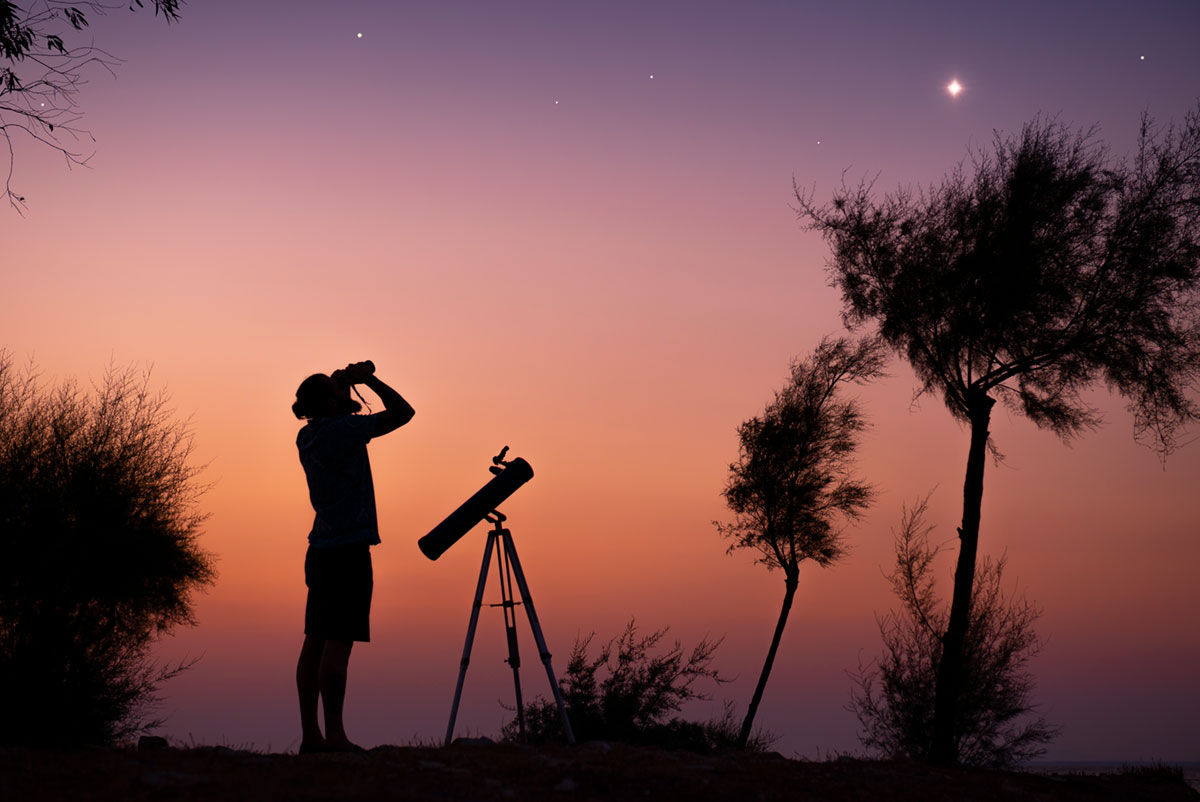
Date:
Interested in buying a telescope? Making the right purchase need not be a daunting task if you're armed with a few simple guidelines. There are several different types of telescopes on the market and the first place to start in choosing one is to decide what you want to do and how much you want to spend.
Are you a beginner? A casual observer? Or are you an experienced sky observer? If you're a beginner or a casual observer, this guide's for you. You'd probably like to see the moon up close, observe the planets or get a good look at a passing comet, but you're not ready or interested in spending the time or money to do astrophotography just yet. You might also like the telescope to have some portability so you can take it to dark sky locations or with you on vacation without much trouble.
Getting Started: Binoculars
The best way for a complete novice to start is with a pair of binoculars. Binoculars have several advantages. They're lightweight, portable, easy to aim, have low powers of magnification and a wide field of view. Just in case you lose interest in astronomy, they can be used for other observing pursuits. Also, they tend to be less expensive than a telescope and you might have a pair already.
Binoculars are rated by their power of magnification and the size or aperture of the front lens. This information is contained in those cryptic numbers on the eyepiece end of the binoculars. They read as 7x35, 7x50 or some combination of numbers on either side of an 'x'. To define the numbers, let's start with the 'x'. It stands for the binoculars' power of magnification. So in 7x35 we have 7-power magnification. Typically, binocular power is usually 7, 8 or 10. The higher numbers like, 10, 15 and the occasional 25-power are rarer and usually quite expensive. They're also impractical for casual observing because you'll need a tripod to hold them without jiggling at 10-power and higher.
The other number is the diameter measurement of the front lenses in millimeters. This number can range from 35 to 70 and higher. As with the magnifications though, the higher the number, the more expensive and more difficult they are to handle. This brings us to our first tenet of buying binoculars or telescopes: Always buy the biggest aperture you can afford. Reason? With bigger lenses or mirrors in your optics, you can gather more light. The primary misunderstanding about telescopes and binoculars is that magnification is your ultimate goal. While magnification is nice, you can't magnify what you can't see. In other words, if you aren't gathering enough light from an object to make it visible, what's the use of magnification? With binoculars purchased for bird-watching or enhancing the view of the game from the nosebleed section, you can also do some casual skygazing. Ordinary binocs will give excellent views of the moon and greatly improved views of Jupiter, Saturn, and comets. Good binocs start at around $65 and go up from there. Check to make sure they're built well and test them by looking at something with lots of vertical lines. You want to make sure that the lines don't curve near the edges of the field and that they have a hard, sharp focus. Did you know that most comet discoveries are made by amateurs with binoculars? Or that those old binocs you have in the drawer at home are more powerful than Galileo's first telescope? Try them. They might just be the best way for you to begin.
Telescopes: The Basics
Telescopes come in two basic types: refractors and reflectors. Refractors use lenses to gather light from dim objects while reflectors use a mirror. Refractors are the long narrow tubes with the eyepiece at the back end. Reflectors are usually shorter, fatter and open at the top. In most styles of reflector, the eyepiece is placed near the top. Refractors provide good, sharp images and are good for observing pinpoint light sources such as stars and planets, but tend to be on the expensive side. Reflectors are good for observing more diffuse light sources such as galaxies and star clouds. They also provide good, sharp images but they are much less expensive because reflectors reflect the gathered starlight from just one surface. In refractors, the light has to pass through two lenses and the surfaces of both (four altogether) have to be polished as close to perfectly as possible. This is both time-consuming and labor-intensive. Going by our first tenet of "always buy the biggest aperture you can afford," you can almost always purchase a much larger reflecting telescope for what you'd spend on a smaller refractor.
In many stores telescopes are sold by their power of magnification. It actually has very little importance in purchasing a telescope because of the second tenet, "you can't magnify what you can't see." As magnification increases, resolution decreases. The rule of thumb for magnification limit in telescopes is 50 power per 25 millimeters (25.4 mm = 1 inch). It works like this: the main lens or mirror of a telescope gathers light from an object and forms a small image inside the tube near the eyepiece. The eyepiece magnifies the small image. Different eyepieces have different magnifications. The numbers on the eyepiece refer to their focal length. If you divide the focal length of the telescope’s main lens by the focal length of the eyepiece, the resulting number is the magnification you'll get with that particular eyepiece. For example:
900 mm focal length (telescope) divided by:
25 mm focal length(eyepiece)
= 36 power magnification
The focal length of the telescope’s main lens or mirror is shown either as a raw number like this:
ƒ = 900mm
Or like this:
ƒ5.6
This is the ratio of the diameter of the lens or mirror to its focal length. Don’t worry about the numbers, it just says the focal length of the lens is 5.6 times the diameter of the lens!
The lower the eyepiece numbers, the higher the magnification. Remember: the rule of magnification is 50 power per 25 mm of aperture. In a 60 mm scope, the best you can do is 100 power. In a 100 mm scope, 200 power and so on. If the advertised magnification is 500 power, the scope size HAS to be 250 mm(10 inches!) or more of aperture, otherwise the loss in resolution will degrade the image dramatically. It's also just plain better to begin with low powers anyway. Telescopes have high magnification and a small field of view - just the opposite of binoculars. Using lower powers of magnification in a telescope make it easier to find and keep track of the objects in view.
Your telescope must have a finderscope, a smaller telescope mounted adjacent to the eyepiece. The finder, with much lower power and much wider field makes object location much easier.
For casual observing, motors to drive the telescope for tracking objects aren't really necessary. After just a little practice you'll find that guiding a telescope by hand as you observe is quite easy, especially at low powers of magnification. Motors are important if you're planning to do astrophotography or perhaps if you plan to show an object to a multitude of people in a short amount of time. For beginners, complication of operation and price are dramatically reduced if you don't have a motor drive - save it for your next, larger telescope.
Computerized "Robotic" Telescopes
The wonders of the digital age have now made it possible for anyone to own what used to be professional observatory-grade optics and highly accurate tracking systems. Many telescopes now have a computerized guiding system that uses an on-board database of hundreds of thousands of objects. The database provides the locations of the objects and the microprocessor control systems run the telescope across the sky to the desired object at the push of a button. Ah, bliss! No longer does the operator have to know where anything is in the sky, the computer will do it all for you, right? Wrong! Even with GPS positioning capability, the operator still has to be able to know the night sky well enough to realize whether or not the guidance system knows what its doing. So you the operator DOES have to know what’s up there to confirm that the scope is pointing accurately - especially at start-up. Otherwise, the scope will just point to where it thinks the object is – oblivious to whether or not an object actually is there. Remember: it’s just a machine, and not a very smart one at that. So don’t expect one of these scopes to do it all for you. They do have advantages but those only become obvious once you really learn how to use the instrument.
The mount or tripod of the telescope should be firm and steady. The more massive the tripod is, the less prone the telescope will be to fall over or to wind vibration. The simplest telescope to set up and use is the Dobsonian reflector. The optic tube just sits in a giant turntable-type mount. It's very easy to operate and could be the best value for your dollar. You'll find them advertised in the magazines listed below.
To make this all worthwhile, you'll need instructions on how to set up and use your telescope. Some of the best books to teach you how to use your telescope are actually the old 8.5x11" black-type-on-white-paper books published by Edmund with titles like How to Use Your Telescope, The Edmund Sky Guide and the MAG 5 Star Atlas. Don't be fooled by their mundane appearance. They are well written, clearly illustrated and give step-by-step directions on how to get the best from whatever instrument you purchase. You can still find them online and in used bookstores.
Looking for a bargain? Consider purchasing a used telescope but - caveat emptor - let the buyer beware! You really have to know your stuff to buy used equipment or have someone knowledgeable do it for you. Check out the Classifieds section at Astromart.com. Good luck and start shopping early!
How to Buy A Telescope: Resources
Websites
• Telescope.com: Orion Telescopes and Binoculars; good primers on what to look for in a scope.
• Skies Unlimited: local PA guys!
• Meade Instruments: one of the "big players" in the industry
• Celestron: the other "big players"
• Astromart: the "craigslist" of amateur astronomy sales
Publications
Astro magazines are getting scarce! They’re still available at your local bookstore, but they all have websites now. Be sure to see their special editions.
• Sky and Telescope: a more technical periodical for a more advanced amateur observer.
• Astronomy: the magazine for all the rest of us. Great articles, prettier pictures.
Basic Telescope Formulae:
• Mag = fL(objective)/ fL(eyepiece)
• fL = distance from objective to focal point
• Pitts’ Power Law - 50x/in(aperture)
• Price x Weight = Immovability
• Use(scope) is inversely proportional to Mass
Astronomy Clubs in the Delaware Valley:
• Delaware Astronomical Society
• Delmarva Stargazers
• Amateur Astronomical Association of Princeton
• South Jersey Astronomy Club
• West Jersey Astronomical Society (formerly known as the Willingboro Astronomical Society)
• Bucks-Mont Astronomical Association
• Ches-Mont Astronomical Society
• Delaware Valley Amateur Astronomers
• Rittenhouse Astronomical Society
Derrick H. Pitts is the Chief Astronomer and Planetarium Programs Director of the Fels Planetarium at The Franklin. He’s been a ‘telescope jockey’ for 40 years. You can reach him at dpitts@fi.edu, 215-448-1234.


